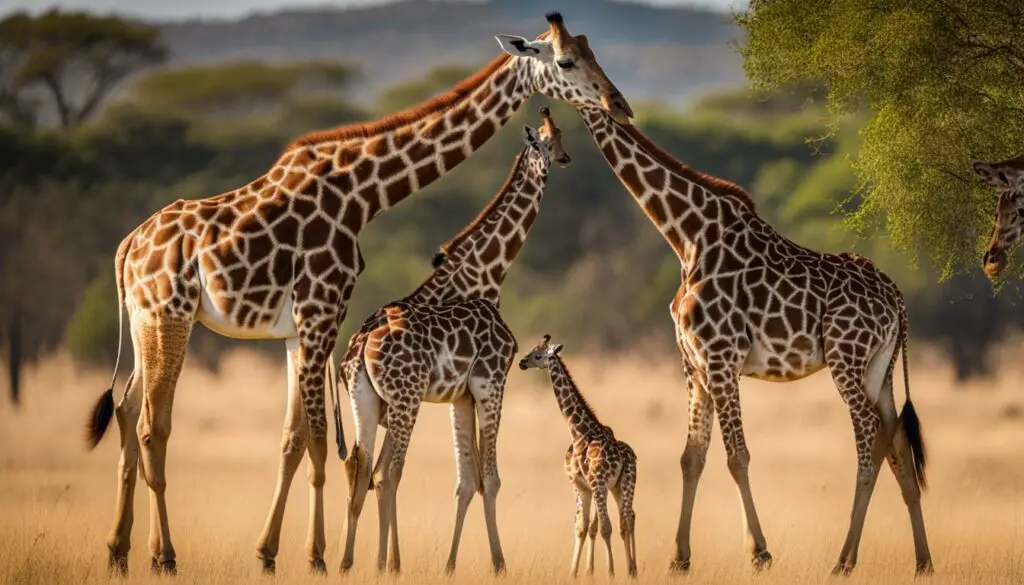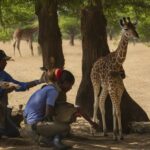Welcome to our blog post on the fascinating world of giraffe reproduction and calf development. In this article, we will explore the gestation period of giraffes, their unique mating behaviors, and the habits involved in breeding. We will also delve into the different stages of a giraffe calf’s development, from birth to their growth within the herd.
But first, let’s take a moment to appreciate the magnificent creatures themselves. Giraffes are known for their long necks, graceful movements, and stunning patterns. They are among the tallest animals on Earth, with some individuals reaching heights of up to 5.5 meters (18 feet)! Their reproduction process is just as remarkable as their physical appearance, so let’s dive right in.
Throughout this article, we will touch upon topics such as giraffe reproduction and birth, giraffe mating behaviors, the gestation period of giraffes, their breeding habits, and the development of giraffe calves. So, whether you’re a wildlife enthusiast, a lover of giraffes, or simply curious about the wonders of nature, this article is for you!
Giraffe Courtship and Mating Behaviors
Giraffes, with their majestic appearance and unique physical features, have equally fascinating courtship and mating behaviors. These behaviors play a crucial role in the reproductive cycle of giraffes, ensuring the survival and continuation of their species.
One of the most notable courtship rituals among giraffes is necking. This is when males use their long necks to swing their heads and deliver blows to their opponent’s body. Necking serves as a form of competition, where males establish dominance and determine the right to mate with available females. It’s a remarkable sight to witness these graceful giants gracefully engage in this behavior.
The reproductive cycle of giraffes encompasses courtship, mating, gestation, and birth. Interestingly, it is believed that some giraffe cows return to the place of their own birth to give birth to their own calves. This behavior showcases a remarkable instinct to ensure the safety and well-being of their offspring. Although we have gained some understanding of giraffe courtship and mating behaviors, there is still much to learn about the intricacies of their reproductive lives.
| Giraffe Courtship and Mating Behaviors | Description |
|---|---|
| Necking | Males swing their heads and deliver blows to establish dominance |
| Reproductive Cycle | Involves courtship, mating, gestation, and birth |
| Birthplace | Some giraffe cows return to the place of their birth to give birth |
As we delve deeper into understanding giraffe courtship and mating behaviors, we gain valuable insights into the complexity of their lives. These behaviors are not only fascinating to observe but also essential for the continuation of the giraffe population. By protecting and conserving their natural habitats, we can ensure that future generations will continue to witness the majestic courtship and mating rituals of these incredible creatures.
Giraffe Calving and Calf Development
Giraffe calving is a fascinating process that results in the birth of relatively large and independent newborns. These majestic animals give birth to calves that are already 1.8 meters (6 feet) tall and weigh around 65 kilograms. This remarkable size allows them to quickly adapt to their surroundings and begin their journey in the wild.
Upon birth, giraffe calves are able to stand, feed, and walk within hours. This early mobility is crucial for their survival, as it allows them to keep up with their mothers and the rest of the herd. It also enables them to access the necessary resources, such as food and water, to support their growth and development.
Giraffe calf development is rapid, with calves doubling their height in the first year. They rely on their mother’s milk for 9-12 months before transitioning to solid food, which predominantly consists of leaves. This gradual shift in diet prepares them for a life of browsing in the treetops, where they can reach their favorite food sources.
Giraffe Reproductive Anatomy
Giraffes possess unique reproductive anatomy that enables successful calving. The mother’s reproductive system is specially adapted to accommodate the long gestation period and the birth of large calves. Additionally, giraffes have a short umbilical cord that is snapped upon birth, allowing the calf to take its first breaths and stand independently.
The following table provides a detailed overview of giraffe calving and calf development:
| Aspect | Description |
|---|---|
| Size at Birth | 1.8 meters (6 feet) tall, weighing approximately 65 kilograms |
| Early Mobility | Calves can stand, feed, and walk within hours of being born |
| Dependency on Mother’s Milk | Relies on mother’s milk for 9-12 months before transitioning to solid food |
| Rapid Growth | Calves double their height in the first year |
| Reproductive Anatomy | Unique adaptations for gestation and birthing of large calves, including a short umbilical cord |
Understanding the process of giraffe calving and calf development contributes to our knowledge of these remarkable creatures and aids in their conservation. It highlights the resilience and adaptability of giraffes, allowing us to appreciate their incredible journey from birth to adulthood.
The Importance of Mothers and Herd Dynamics
When it comes to giraffe calf protection, mothers play a vital role in ensuring the safety and well-being of their young. These majestic creatures are known for their strong instincts to defend their calves from potential threats. If any animal comes too close to a giraffe calf, the mother will not hesitate to use her powerful kicks to ward off intruders. This protective behavior greatly increases the chances of survival for the vulnerable newborns.
In addition to individual mother-calf bonds, giraffes also exhibit interesting herd dynamics that contribute to the overall protection and development of the calves. Nursery groups have been observed in the wild, where one mother keeps a watchful eye while the others go in search of food. This cooperative strategy allows for shared responsibility, ensuring that at least one adult can provide immediate protection to the calves while the others graze.
During the first few days of a giraffe calf’s life, it spends most of its time in high grass while the mother ventures off to feed. However, after a few weeks, the calf is introduced to the rest of the herd. This transition period is crucial for the calf to learn social behaviors and build relationships within the group. The herd dynamics play a significant role in the calf’s development, as they learn from older members and benefit from the safety of numbers.
Understanding the important role that mothers and herd dynamics play in giraffe calf protection can help researchers and conservationists develop effective strategies to ensure the survival and well-being of these magnificent creatures. By studying and preserving their natural behaviors, we can contribute to the long-term conservation of giraffes and their unique social structures.

Giraffe Calf Protection Strategies:
- Mother’s fierce kicks to defend against threats
- Nursery groups with shared protective responsibilities
- Introduction of calves to the larger herd for socialization
Benefits of Herd Dynamics:
- Learning social behaviors from older members
- Safety in numbers
- Opportunities for cooperative feeding and protection
Conclusion
Understanding the fascinating processes of giraffe reproduction and birth is crucial for the conservation and survival of these magnificent animals. Giraffes have a long gestation period of approximately 15 months, and their calves are born relatively large, standing at an average height of 1.8 meters and weighing about 65 kilograms. Witnessing a giraffe giving birth while standing is truly a remarkable sight, as the newborn calf gracefully falls to the ground from a height of about 6 feet.
Giraffe calf development is equally impressive. Within hours of being born, the calves are already able to stand, feed, and walk. They rely on their mother’s milk for 9-12 months before gradually transitioning to solid food, such as leaves, at around 4 months of age. These young giraffes grow rapidly, doubling their height within the first year of life. However, their vulnerable early months are marked by potential threats from predators such as lions, hyenas, and wild dogs.
The importance of mothers and herd dynamics cannot be overstated in the upbringing of giraffe calves. Giraffe mothers are extremely protective and will not hesitate to kick any animal that poses a threat to their offspring. Nursery groups have been observed in the wild, where one mother stands guard while the others search for food. Initially, newborn giraffes spend their first few days hidden in tall grass while the mother forages, but they are eventually introduced to the rest of the herd. Female calves tend to stay in the same herd as their mothers, while male juveniles join all-male groups.
By studying and comprehending the intricate details of giraffe reproduction, calf development, and herd dynamics, we can contribute to the preservation of these magnificent creatures. Ensuring the survival and well-being of giraffe populations is not only crucial for their species but for our planet’s biodiversity as a whole. Let us appreciate and protect these extraordinary animals for generations to come.
Do Koalas Have a Similar Birthing and Raising Process as Giraffes?
Koalas’ social behavior in the wild is quite different from giraffes. While giraffes give birth standing up, koalas give birth while sitting in trees. Additionally, giraffes are known to form social groups, whereas koalas are more solitary animals. They do not have similar birthing and raising processes due to their distinct social behaviors.
FAQ
What is the gestation period for giraffes?
The gestation period for giraffes is approximately 453-464 days, or about 15 months.
How do giraffes give birth?
Giraffes give birth standing up, with the newborn calf falling to the ground from a height of about 2 meters (6 feet).
How big are newborn giraffes?
The average height of a newborn giraffe is 1.8 meters (6 feet) and they weigh about 65 kilograms.
How long do giraffe calves rely on their mother’s milk?
Giraffe calves rely on their mother’s milk for 9-12 months before transitioning to solid food.
What are the threats to giraffe calves in their early months?
The first few months of a giraffe’s life are the most vulnerable, with predators such as lions, hyenas, and wild dogs posing a threat.
When do giraffe calves leave their mothers?
Male calves typically leave their mothers at around 15 months, while female juveniles may stay with their mothers or leave at around 18 months.
Do giraffes have breeding seasons?
Giraffes do not have formal breeding seasons and can adjust their feeding patterns seasonally to maintain a high nutrient diet.
What are the courtship rituals of giraffes?
Courtship rituals among giraffes involve necking, which is when males use their necks to swing their heads and deliver blows to their opponent’s body.
What is the reproductive cycle of giraffes?
The reproductive cycle of giraffes includes courtship, mating, gestation, and birth.
Do giraffe cows return to where they were born to give birth?
It is believed that some giraffe cows return to where they were born to give birth to their own calves.
How quickly do giraffe calves grow?
Giraffe calves grow quickly and can double their height in the first year.
Have twins been recorded in giraffes?
Twins have been recorded in giraffes, although it is more common for them to have only one calf.
What is the behavior of giraffe mothers towards their calves?
Giraffe mothers are extremely protective and will kick any animal that comes too close to their calves.
Are there nursery groups among giraffes?
Nursery groups have been observed in the wild, where one mother keeps watch while the others go and find food.
When do giraffe calves join the rest of the herd?
The first few days of a newborn giraffe’s life are spent in high grass while the mother goes off to feed, but after a few weeks, the calf is introduced to the rest of the herd.
What is the role of herd dynamics in raising giraffe calves?
Herd dynamics play a role in the raising of giraffe calves, with females often staying in the same herd as their mothers while males join all-male groups.
Why is understanding giraffe reproduction and calf-raising important?
Understanding the intricacies of giraffe reproduction and calf-raising is important for conservation efforts and ensuring the survival of these magnificent animals.










